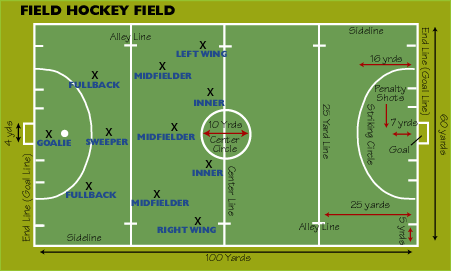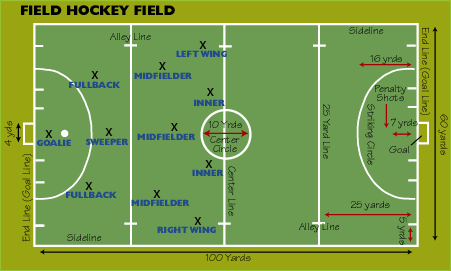Field Hockey 101

Introduction
Hockey is a stick and ball game with origins dating back thousands of years. It is traditionally played on grass, but more often it is played on synthetic surfaces. Two teams compete using ‘hooked’ sticks to hit, push, pass and dribble a small, hard ball with one aim in mind – to score a goal by getting the ball past the goalkeeper.
Teams
There are 11 players on the pitch with up to five substitutes on the side-line. Players can substitute virtually at any time and any number of times.
Player positions
Every team has a goalkeeper – although, rarely, a team will play only with field players to put more players into attack. The other 10 players are called ‘field players’, and are in three categories – attackers, midfielders, and defenders.
Stick handling
Hockey players must be able to control, pass, push, stop and hit the ball with a hockey stick. This is known as stick work or stick handling. Keeping the ball under close control is called dribbling. The head of a hockey stick has a rounded side (the right side) and a flat side (the left side). It is only with the flat, left-hand side of the stick and the edges of that side which can be used to play the ball.
No feet!
Field players are not allowed to use their feet (or any other parts of their bodies) to control the ball. Only the goalkeeper is allowed to use hands, feet, etc. to stop or propel the ball when defending in his or her own circle.
Ball in the air
In general play, the ball cannot be raised into the air when hit. It can though be raised by using a scooping or long pushing action of the stick. A player will be penalized if they lift the ball in a way which is dangerous to another player. When the ball is in the air, a player must not play it above shoulder height. A defender can use their stick at any height to save a shot at goal – because attackers are allowed to raise the ball when trying to score a goal. Many shots are raised because it is an effective way of scoring goals.
Field Goals
Field goals may only be scored from within the ‘circle’, which is a roughly semi-circular area in front of the opponents’ goal. If an attacker hits the ball from outside the ‘circle’ and it goes into the goal or is touched by a defender on the way, it does not count.
Penalty Corner
If a defending team breaks certain rules, the other team can be awarded a ‘penalty corner’. Normally this happens when a team breaks a rule within their own ‘shooting circle’, but these can also be awarded when a defender is guilty of a particularly bad foul in the defending quarter of the field.
For a penalty corner, play is stopped to allow the teams to take their positions. One attacker stands with the ball on the backline. This player will ‘push out’ the ball to other attackers waiting to take a shot. The other attackers wait at the top of the shooting circle to get the ball.
Up to five defenders (including the goalkeeper) position themselves behind the backline to defend. The rest must stay behind the halfway line until the ‘push out’ is taken. The ball is ‘pushed out’ to one of the attackers. Before a shot can be taken, the ball must first travel outside the circle. The receiver then usually pushes it back into the circle for a shot either by themself or another attacker.
If the first shot is a hit (as opposed to other types of shots, like a ‘flick’ or a ‘scoop’), the ball must enter the goal no higher than 460mm. It is easy to tell if the ball is at that height because the board at the back of the goal is the same height.
If the first shot is a ‘scoop’ or a ‘flick’ (shots that are lifted into the air with a long scooping or pushing action of the stick) then the ball can cross the goal-line at any height. Once the attacker on the backline begins to push the ball out, the defenders on the back line may move into the circle.
Penalty Strokes
A penalty stroke may be awarded for several reasons, the most common being an offence by a defender in the circle that prevented a goal. In a penalty stroke, a shot is taken by one player and defended only by the goalkeeper. The shot is taken from 6.4 meters directly in front of the goal. All other players must stand outside the circle, about 23 meters away. Match time is stopped during a penalty stroke.
Free Hits
For general offences, a free hit is given against the team which fouled. Common fouls are obstructing an opponent from playing the ball, interfering with the stick or body when tackling, kicking the ball, and playing the ball dangerously.
For a free hit, opponents are given the ball where the offence took place. The ball is initially stationery and play will often be re-started by passing the ball to a teammate nearby while all opponents are 5 meters away. However, the player taking the free hit can also begin to dribble the ball him/herself.
Duration of a match
A regulation hockey match lasts 70 minutes (high school matches are 60 minutes) – which is broken into two halves of 35 minutes each with a break of 5 to 10 minutes. The team with the most goals at the end of the 70 minutes is the winner. It is also possible for a match to end in a draw. But in some matches – such as a championship game – there must be a winner. In those cases, a match which is tied, it goes into extra time (the first team to score wins), and if necessary, to a shootout.
Umpires
Each match is controlled by two umpires. Each umpire controls half of the pitch and works cooperatively in the middle part of the pitch.
For bad or repeated offences by players, an umpire can show them a card. A green card is a warning. A yellow card means the player is suspended from the game for a minimum of 5 minutes or the time the umpire decides depending on the nature of the offence. A red card is for a very serious offence and means the player is suspended for the remainder of the match. If a player is suspended temporarily or permanently, their team plays with fewer players.
At world level competitions where the facilities are available, a team playing or the umpires themselves can refer a decision to the video umpire who can use slow motion replays to advise the umpires on the pitch of the correct decision. Source: http://www.fih.ch/en/fih/sport/rules/hockey101
